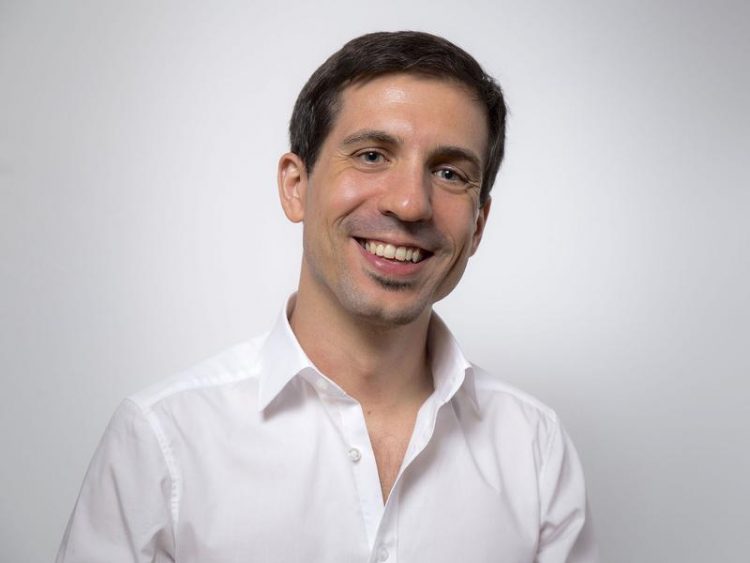‘Find the Lady’ in the quantum world

Dr. Andrea Alberti from the Institute of Applied Physics (IAP) at University of Bonn. (c) Photo: Jose C. Gallego
Imagine that you are playing the game of ‘Find the Lady’ – in fact, a very simple version of it: The croupier is no hardened con artist, but rather a thoroughly honest woman. And on the table in front of her are just two cups, not three. These are made from black plastic and look so darned alike that – try as you might – you cannot distinguish one from the other.
The croupier now begins to move both cups backward and forward. Her moves are very fast and dexterous. Nevertheless, with a little concentration, you manage to follow her moves. At the end, you can correctly state which of the cups was originally on the left and which on the right.
But what would happen if you close your eyes when the cups are being moved? In this case, you can only guess: after all, to you, both cups look completely identical. Of course, they aren’t really so: cup 1 remains cup 1, no matter how often it changes places with cup 2.
However, in the world of the smallest things, experiments can be performed in which the thing of identity is not that clear. Playing a game such as ‘Find the Lady’ in the quantum world has now been proposed by physicists at the Institute of Applied Physics (IAP) of the University of Bonn together with their colleagues from Austria and the USA.
In different places at the same time
In the quantum world, the cups are replaced by two atoms that are exactly in the same atomic state. “Such atoms can be produced in specialized laboratories with state-of-the-art techniques,” explains Prof. Dieter Meschede from the IAP. “They are actually completely the same and only differ due to the position at which they are located.”
When you play ‘Find the Lady’ in the world of atoms, you have some extra freedom. For instance, researchers can count on the quantum mechanical phenomenon according to which particles can be in two different places at the same time. By cleverly using this phenomenon, atom 1 and 2 can, with a certain amount of luck, swap places without anyone noticing.
In other words: at the end of the quantum manipulation, the observer has no way to say – as a matter of principle – whether atom 1 is actually still atom 1 or whether it has been swapped with atom 2. For standard cups, it would still be possible to tell them apart reliably using their tiniest differences such as a microscopically small dent. This is not the case for identically prepared atoms; they are exactly the same. “At the end of the experiment, it is thus no longer possible – in whatever form – to identify which of the two atoms is number 1 and which is number 2,” explains Dr. Andrea Alberti from the IAP.
This also has philosophical implications. The German philosopher Gottfried Wilhelm Leibniz (1646–1716) is credited with the assertion that two objects are identical when no differences can be discerned between them. Following Leibniz’s logic, the switched atoms must have then lost part of their individuality: they are two, yet they are somehow one.
Astoundingly, both of them are also ‘connected’ to each other after switching places: certain properties of both particles such as the spin – the direction of rotation of an atom – depend upon both particles. If you observe the spin orientation of atom 1, then you will immediately know the spin orientation of atom 2 – even without directly observing it. “It is as if you throw two coins independently of each other,” explains Andrea Alberti. “If one coin shows heads, then this must also be the case for the other.” Physicists talk of ‘entanglement’.
The IAP researchers are currently working on putting their theoretical proposal into practice. The experiment can also be performed in a modified form with other particles such as ions – a route that the colleagues at the Institute for Quantum Optics and Quantum Information in Innsbruck of the Austrian Academy of Sciences want to take. “We expect from these studies, in which we control with high precision exactly two quantum particles, new findings on the fundamental quantum mechanical exchange principle,” hopes Alberti.
Publication: C. F. Roos, A. Alberti, D. Meschede, P. Hauke, and H. Häffner: Revealing Quantum Statistics with a Pair of Distant Atoms; Physical Review Letters
Contact:
Dr. Andrea Alberti
Institute of Applied Physics (IAP)
University of Bonn
Tel. +49 (0)228/733471
E-mail: alberti@iap.uni-bonn.de
http://dx.doi.org/10.1103/PhysRevLett.119.160401 Publication
Media Contact
More Information:
http://www.uni-bonn.de/All latest news from the category: Physics and Astronomy
This area deals with the fundamental laws and building blocks of nature and how they interact, the properties and the behavior of matter, and research into space and time and their structures.
innovations-report provides in-depth reports and articles on subjects such as astrophysics, laser technologies, nuclear, quantum, particle and solid-state physics, nanotechnologies, planetary research and findings (Mars, Venus) and developments related to the Hubble Telescope.
Newest articles

Superradiant atoms could push the boundaries of how precisely time can be measured
Superradiant atoms can help us measure time more precisely than ever. In a new study, researchers from the University of Copenhagen present a new method for measuring the time interval,…

Ion thermoelectric conversion devices for near room temperature
The electrode sheet of the thermoelectric device consists of ionic hydrogel, which is sandwiched between the electrodes to form, and the Prussian blue on the electrode undergoes a redox reaction…

Zap Energy achieves 37-million-degree temperatures in a compact device
New publication reports record electron temperatures for a small-scale, sheared-flow-stabilized Z-pinch fusion device. In the nine decades since humans first produced fusion reactions, only a few fusion technologies have demonstrated…





















